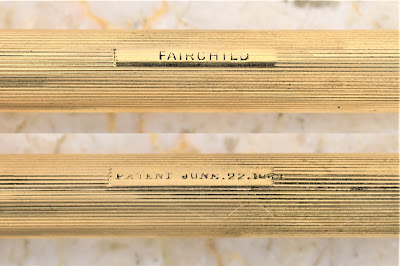This article has been included in The Leadhead's Pencil Blog Volume 7, now available here.
If you don't want the book but you enjoy the article, please consider supporting the Blog project here.
I’ve photographed several Victorian-age pencils lately that are worthy of discussion but would make for pretty short articles on their own. This first pair came in an online auction together:
Pair of pairs, I should say. Neither had leads in them, but I had some down at the Legendary Lead Company that fit and function fine. I was going to pass one on to Joe, but with two patterns of double ended Fairchilds, I couldn’t decide which one I could stand to part with:
Next is a rather conventional hard rubber magic pencil. I don’t remember whether I specifically targeted this one, or whether I noticed what was special about it only after it arrived:
It’s also marked Fairchild, but with an interesting patent date:
Looks like the makers could have used a cartouche that was a bit longer . . . June 22, eighteen sixty-something, it reads. Tasks like this are a job at which American Writing Instrument Patents 1799-1910 excels: all I had to go down the list looking for a year in which a patent was issued on June 22, and I found it – June 22, 1869:
And that’s interesting . . . first, because it was a patent issued to John Rauch, stamped on a Fairchild. The “Victorian Mafia” of penmakers in New York made a deal to share technology and cut down on counterproductive competition (Volume 5, page 94), but the last time this patent turned up it was in connection with Mabie, Todd & Co., a more likely association given the connections between John Mabie and John Rauch (Volume 4, page 167).
What’s even more interesting is that in that last article, the patent turned up on a combination pen/pencil, and the pencil operated by advancing in the same direction it was pulled (a “sportsman” design, I’ve always called it), rather than in the opposite direction:
Next up is another magic pencil, but with a twist:
That tapered front end is unusual; although I’ve seen pencils in that shape, most are unmarked. Not so with this one:
With the “Big H” mark, for William S. Hicks – by that time the firm was known as William S. Hicks’ Sons, since the Big H trademark wasn’t used until November 1, 1912 according to the registration certificate (see Volume 5, page 66).
Last of the odds and ends is a pair of unmarked slider pencils, probably dating between the late 1840s and the Civil War. These don’t attract much collector attention when they lack a maker’s imprint:
Sometimes, however, there is other historical value based on whatever personalization has been added to these, so I make it a habit to examine that before consigning them to the sale or parts bins. I did a double take with the first one, then quickly grabbed my loupe for an even closer look:
At first I thought it was engraved “L.W.F.,” which got my heart pumping thinking this might once have been owned by Leroy W. Fairchild. Alas – that nice, flowery engraving actually says “S.M.F.” Oh well . . . you’ll see it on display at my next pen show. Then I looked at the other one:
And then I looked harder . . . yep, it says “A.G.B.” Could Albert G. Bagley have carried this in his pocket and jotted nasty notes to his former partners with it?
Sure, that’s a longshot. But think about it: yes, some initials are more common than others, but there are 17,576 different combinations of initials, and there were only 23 million people in the United States in 1850. Ignoring that some combinations are more common than others, that’s an average of just over 1,300 people per combination.
Now lets assume that this pencil was probably made on the east coast and didn’t go far . . . if it was made in the New York area as I suspect, there were only 515,000 people or so there in 1850 . . . that’s 29 people for each combination.
There’s no way to prove anything and I know the calculation is flimsy. It’s just fun to think about.













No comments:
Post a Comment